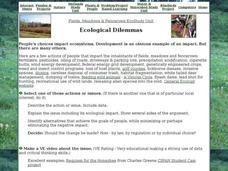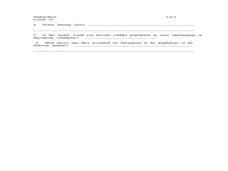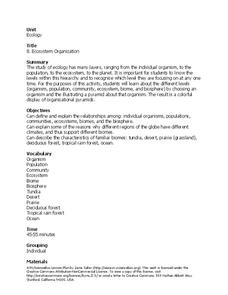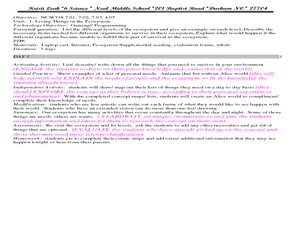Curated OER
Impact of Invasive Species on Food Webs and Ecosystems
Fifth graders explore how invasive species affect the Great Lakes. In this science lesson, 5th graders research invasive species and create a food chain involving the invasive species. Students discuss how the environment is affected by...
Curated OER
Are There Too Many Elk?
Students use information about elk populations in Arizona to make recommendations about population management. In this ecology lesson, students discover the problems associated with having a heard of elk that is too large. After...
Curated OER
Water Cycle and Ecosystems
Young scholars explore the water cycle. In this investigative lesson, students examine the water cycle process. They will record their observations and discuss marine and freshwater ecosystems.
Curated OER
Ecological Dilemmas
In this ecological dilemmas worksheet, students read about people's impact on ecosystems. Students complete 3 activities that require them consider the negative impact humans have on their environment.
Curated OER
Seals, Corals, and Dollars...
Students explore the interdependence of animals and their habitat. In this Hawaiian ecology lesson, students work in groups to research the necessity of preserving precious coral as a habitat for monk seals. Students prepare and share...
Curated OER
Terraqua Column
Sixth graders create a TerrAqua column. In this ecosystems lesson, 6th graders build a TerrAqua column to conduct investigations on how living things impact the ecosystem.
Curated OER
Oh Panther
Learners play a game that replicates the balance of prey and predators in an ecosystem. In this physical education lesson plan, students follow the instructions to play "Oh Panther!" Learners collect data regarding the game and discuss...
Curated OER
Ecosystem Organization
Learners examine the structure of ecosystems. In this ecology lesson, students listen to a lecture on relationships among organisms and biomes. Learners use the information to create ecosystem organization pyramids.
Curated OER
The Living Environment
Students explore the cycles of an ecosystem. In this environmental science lesson, students work in groups to research the nitrogen cycle, the water cycle, or the oxygen-carbon dioxide cycle. Students prepare a PowerPoint or other...
Curated OER
Edible Soil
Students model the soils layers using Oreo's. In this lesson students use their favorite food items to create a model of soil layers. A discovery lesson from a youth camp is adapted for classroom modeling and discussion of soil ecology....
Curated OER
Diversity Ecosystems
Students work in teams to characterize their biomes and compare them to the biomes of the rest of the class. In this biomes lesson plan, students complete a bean activity, relate it to the diversity in biomes, and then research and...
Curated OER
Under The Sea
In this resource instructional activity, learners use non-fiction books to research ocean animals. Students discover the many features of non-fiction books and how to use these features to help them conduct research. Learners then...
Curated OER
Biodiversity
Students complete activities to study the importance of biodiversity. In this biodiversity lesson plan, students find images to categorize into organism groups and illustrate their interconnections. Students use measurement tools to...
Curated OER
Habitat, What is That?
Students explore animal habitats. In this environmental stewardship lesson, students match animals to their habitats in a classroom activity. Students also observe a firefly habitat and read Fireflies. Students create bulletin boards...
Curated OER
Habitat survival
Sixth graders study different environments and how the food chain affects the survival of different animals. In this environments lesson plan, 6th graders share the visuals which describe the characteristics of the environment that they...
Curated OER
Tales of Truman's Travels Fifty Years Ago
Fourth graders study President Truman and the Whistlestop Campaign. In this US history lesson plan, 4th graders complete a KWL about President Truman and write letters to stops on Truman's Whistlestop Campaign. Students create a...
Curated OER
Student Exploration: Pond Ecosystem
In this student exploration-pond ecosystem worksheet, students use the Pond Ecosystem Gizmo to measure oxygen concentrations and temperature and record the data on charts.
Curated OER
Living Things in the Ecosystem
Sixth graders explore survival in ecosystems. In this ecosystem activity, 6th graders examine what the outcome would be if different organisms were unable to survive in their ecosystems. Students conduct inquiry research regarding the...
Curated OER
Organisms and Their Environment
Students explore Earth's biosphere. In this biosphere lesson plan, students participate in group activities regarding biotic and abiotic factors, population density, and species' habitats.
Curated OER
Learning from the Video Clips
Students view a wilderness video and write to explain the purpose of the video. In this wilderness video lesson, recognize how physical and living parts of the environment interact. Students understand how an ecosystem works.
Curated OER
Your Own Fresh Water Aquarium in the Classroom
Learners explore aquariums. In this fish and ecosystems lessons, students establish a freshwater aquarium environment using materials provided. Learners read about and care for the classroom fish.
Curated OER
School Yard Park/ Ecosystem
Fifth graders examine ecosystems in their schoolyard. In this nature and ecosystem lesson, 5th graders map their schoolyard into workable plots. They classify plants and animals found in the plot. They revisit their site every two weeks...
Curated OER
Living in a Watershed
Fourth graders examine watersheds. In this ecosystem lesson, 4th graders discover what a watershed is and identify the local watershed they live in. Students investigate the attributes of a watershed as well.
Curated OER
Who Will Care for the Water?
Students discover how humans impact natural resources. In this environmental instructional activity, students identify water resources in the local area and construct a T-chart to compare the positive and negative effects humans have on...

























